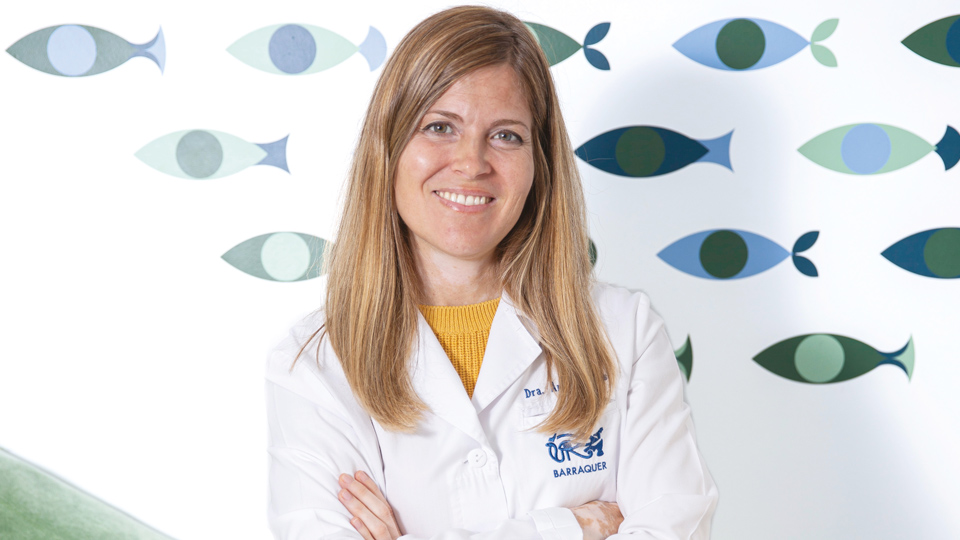Refraction or prescription
31/03/2025

26/11/2024
She graduated in Medicine and Surgery from the University of Barcelona (2005), she specialized in Ophthalmology at the Bellvitge University Hospital (2010). She combines her clinical work with teaching and is a resident tutor and associate professor at the Universitat Autònoma de Barcelona on the Germans Trias i Pujol University Hospital Campus. In 2023, she joined the team at the Barraquer Ophthalmology Centre.
What led you to study Medicine and specialize in Ophthalmology?
At home, I had many medical role models, and from a young age, I knew I wanted to be a doctor. Ophthalmology interested me during my degree for several reasons: first, because it is a medical-surgical specialty—I was clear that I wanted to operate and spend time in the operating room; second, because there is a lot of patient interaction; and finally, because it is a very decisive specialty that allows for a great deal of autonomy.
Why did you dedicate yourself to paediatric ophthalmology?
As a resident, my first rotation was at the San Joan de Déu Hospital in Barcelona, and I loved working with children. I also appreciated the variety within the subspecialty, as we treat nearly all ocular pathologies in children, such as strabismus, amblyopia, tear duct pathology, childhood cataracts, and conditions affecting everything from the ocular surface to the retina and optic nerve.
I am delighted to have dedicated myself to paediatrics because I am passionate about working with children. They are excellent patients—contrary to popular belief—they are fun, witty, clever, and full of personality despite their young age. They surprise me every day. At the same time, it is incredibly rewarding to be able to help them to the best of our ability.
What is your day-to-day life like? What do you like most about your profession?
I get up early, around 6:30, prepare breakfast, take the children to school, and start work at 8:00 until 14:00–15:00. Three days a week, I also work in the afternoon until 19:00–20:00. The workday is very intense because we see many patients every hour, but at the same time, it is stimulating, fun, and rewarding—I learn something new every day. In a given week, I have days dedicated solely to consultations and others in the operating room. What I enjoy most about my profession is interacting with my patients and performing surgeries.
What are the most common eye problems you see in children?
Refractive issues, such as the need for glasses due to hyperopia, myopia, or astigmatism, as well as lazy eye, strabismus, and allergic conjunctivitis.
What techniques do you use to make children feel comfortable during consultations?
I use stuffed animals and toys to examine babies, speaking to them in a soft tone of voice and avoiding sudden movements. With older children, I address them directly to explain what we are going to do next. I approach them calmly and kindly to convey trust and confidence. You’d be surprised how cooperative most children are!
What are the most exciting advances in your area of specialization in recent years?
Ophthalmology has advanced exponentially in recent decades, particularly in surgery but also in treatments for certain conditions.
In paediatrics, we have been treating the progression of myopia with atropine eye drops for several years, alongside optical and behavioural measures, with excellent results. However, the most exciting development in the last 2–3 years has been the implementation of gene therapy for serious retinal conditions such as retinal dystrophies. This therapy halts the disease's progression and, in many cases, improves the vision of affected patients, both children and adults.
Do you think that prolonged use of screens in childhood is affecting the visual health of the new generations? How can it be prevented or mitigated?
Absolutely. There is scientific evidence that increased near-work activities and decreased time spent outdoors contribute to the onset and progression of myopia in children and adolescents.
Additionally, prolonged screen use can lead to ophthalmic symptoms such as asthenopia (eye fatigue) and dry eyes, as well as more severe issues with concentration, learning, behaviour, and neurodevelopment.
To prevent myopia, the most important strategy is fostering good visual habits. In recent years, pharmacological and optical treatments have also proven highly effective in slowing its progression.
Recommended visual habits include:
Increasing time outdoors: 10–15 hours per week, ideally 2 hours per day.
Reducing screen time: Avoid screens for children under 2 years old, limit use to 1 hour per day for preschoolers, and restrict usage to less than 2 hours per day for children over 6.
Increasing screen distance: Follow the 30-40-50 rule—mobile phones at 30 cm, tablets at 40 cm, and computers at 50 cm.
Relaxing accommodation with the 20-20-20 rule: Every 20 minutes of near work, take a 20-second break to look at something 20 feet (6 meters) away.
By "optical measures," we mean peripheral defocusing lenses (available for glasses and contact lenses) that ordered at the optician's when having the glasses made. Pharmacological treatment involves atropine eye drops, which slow down eyeball elongation, reducing myopia progression by 50–60%. These drops are well-tolerated by children with minimal side effects.
You participated with the Barraquer Foundation in collaboration with the Mumbai Smiles Foundation on a week-long expedition for ophthalmological check-ups in Bangladesh. What lessons did you take away from this experience?
It was an unforgettable experience. We worked alongside the local staff of the Mumbai Smiles NGO—wonderful people who were incredibly hospitable and kind. They do invaluable and necessary work in this country.
From the people of India, I carry with me their dignity, smiles, joy, and happiness despite facing the daily struggles of living in extreme poverty.
With such an absorbing job, what do you do to disconnect?
I enjoy reading, hiking in the mountains, going to the cinema, dining out, and spending time with family and friends!